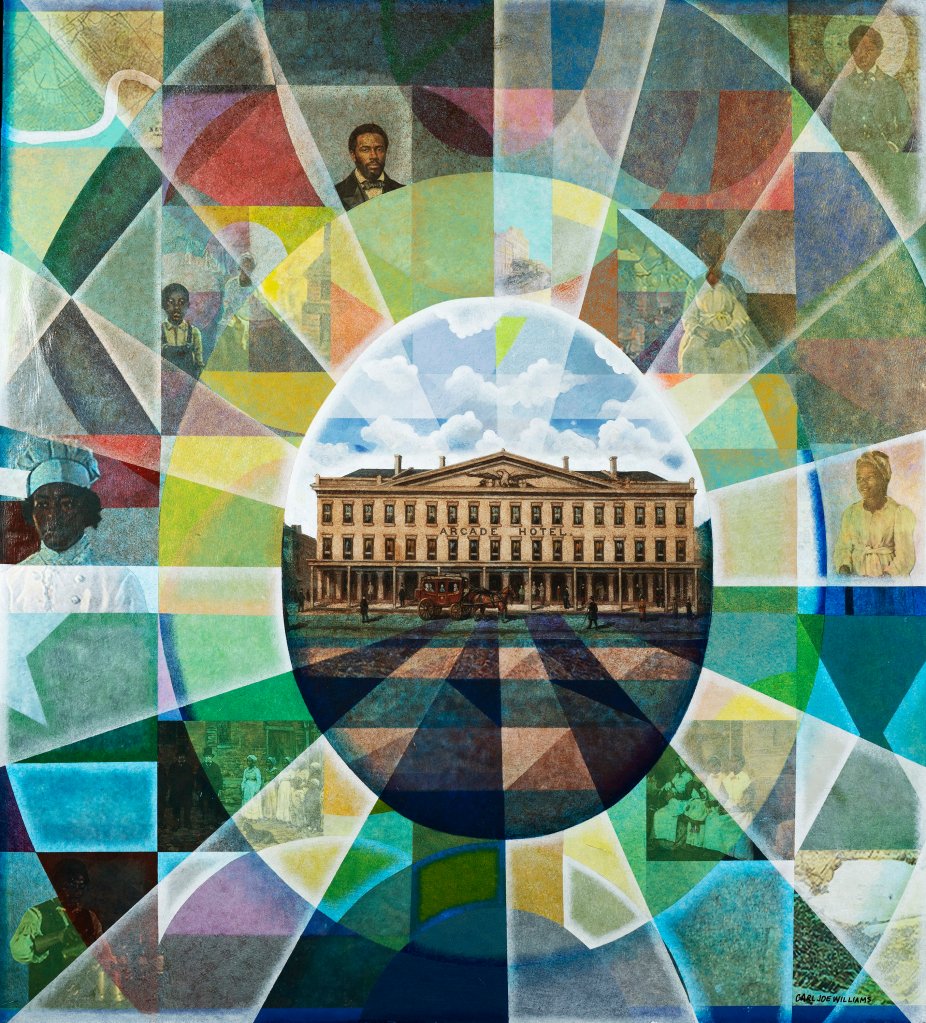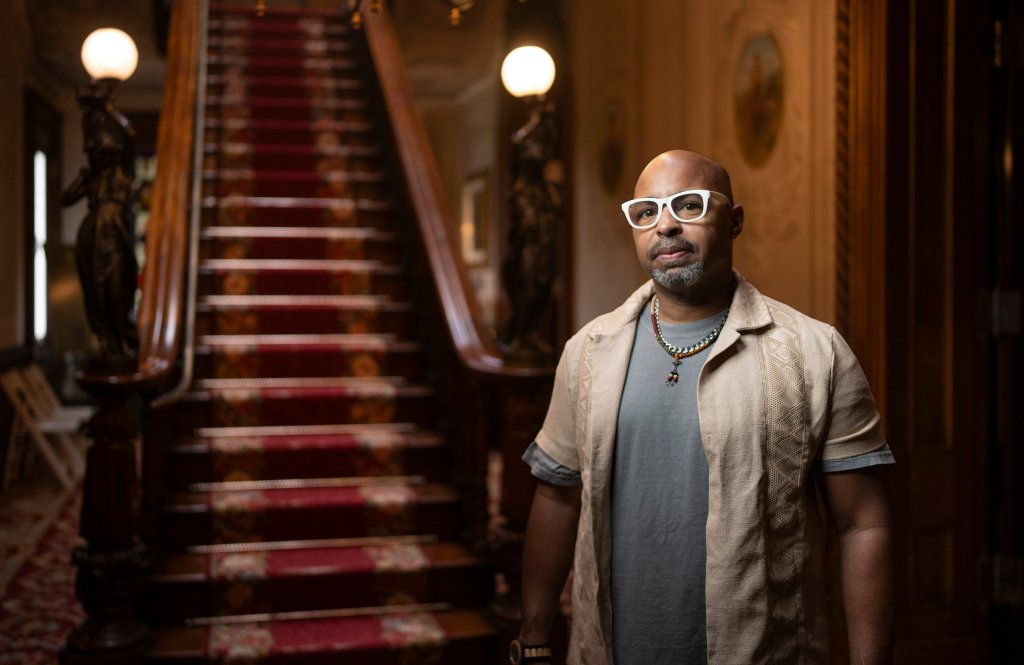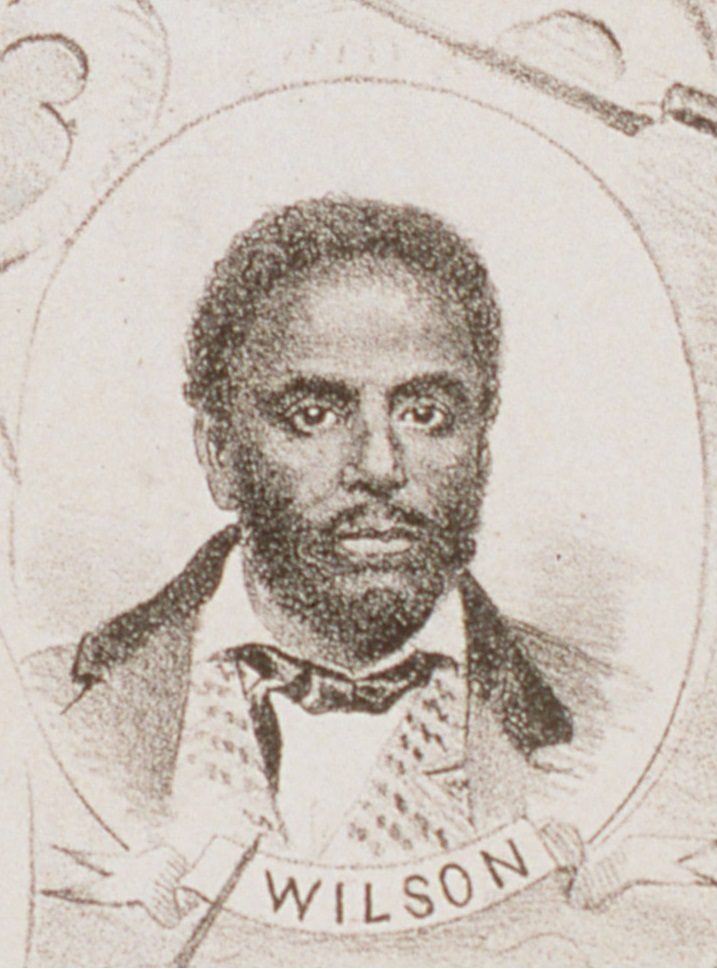
PORTLAND — The Victoria Mansion is a colorful place.
Light filters through blue and yellow stained glass. The carpet in the main stairwell is a rich red. Gold glints from frames, mirrors and chandeliers. Every wall and ceiling is painted with intricate designs.
A visitor might easily miss the small black-and-white portrait in a glass case in the foyer.
Researchers found this image of David Wilson as they were studying the lives of the people enslaved by the family that built the palatial home. Ruggles Morse was a luxury hotelier in New Orleans, and docents at the Victoria Mansion now tell visitors how slavery contributed to his success.
But the photograph of Wilson is the only one they have.
“This is about people and telling their stories, but the information is fragmentary,” Executive Director Timothy Brosnihan said. “In many cases, we don’t have visuals for them.”
The mansion put out a call for an original artwork based on their research, and New Orleans artist Carl Joe Williams responded. He unveiled a painting Wednesday that gives new dimension to this history and will soon be on permanent display at the Victoria Mansion. He calls it “Foundation for the Present, Paid in the Past.”
“It makes you wonder what those people’s lives were really, truly like and the fact that they didn’t really have any control over their lives,” Williams said. “They probably had talents and aspirations and creative notions that couldn’t be fully realized.”

DIGGING DEEPER
Built between 1858 and 1860, the Victoria Mansion was originally a summer retreat for the Morse family.
The home has been a museum since 1941, styled with nearly all of the original furnishings and finishes. The family’s participation in slavery and support of the Confederacy was sometimes briefly acknowledged, but not studied or discussed in depth.
When the pandemic shut down in-person tours, staff and docents used that time for deeper research. They found newspaper archives about the Morses’ social lives and business dealings — including slave auctions common in New Orleans at that time.
In 2021, the mansion launched the Unwilling Architects Initiative to learn more about the enslaved people Morse used to build his fortune.
That project has identified at least 27 men, women and children who were bought and sold by the family in Louisiana. They likely never came to Maine, but the staff felt a responsibility to tell their stories.
“A focus of the past five years in particular has been to explore the human history more thoroughly, not just as an important piece of decorative art and art history, but also as a jumping-off point for exploring other themes in American history through the people who were connected to this building,” Brosnihan said.
The staff created an exhibit in the central stairwell to display the initial findings, including a list – mostly just first names — of the people enslaved. The information was added to the website and a visitor pamphlet was created.
Recent discoveries have included an ad Morse placed in the Daily Picayune in 1859 offering a $25 reward for the arrest of an escaped waiter at the Arcade Hotel named Jo. Stacia Hanscom, director of education and public programs, said they have not yet found any record of what happened to the man, but hopes the lack of information means he reached freedom.
“Everything is black-and-white copies of newspaper articles,” Hanscom said. “We don’t have any objects or material culture to tie into this story.”
‘BLACK HISTORY IS EVERYWHERE’
The Victoria Mansion got a $3,000 grant from Coffee By Design’s Rebel Blend Fund to commission an original artwork, and Indigo Arts Alliance helped spread the word.
Jordia Benjamin, executive director of Indigo Arts Alliance, said contemporary art can be a bridge between the past and the future.
“How do we link the past with our present? How do we envision what our future can be?” Benjamin said. “Artists are leaders in that area and have the gift of being able to visualize and provide a path to those futures.”
She immediately encouraged Williams, who came to Portland in 2021 for an artist residency at Indigo Arts Alliance, to apply. His work includes painting, murals, sculpture, music and video installations, and his own practice is inspired by history, both personal and global.
“Carl is someone I would consider to be a world builder in a very real way,” said Ashley Page, studio and program manager at Indigo Arts Alliance. “He is really thinking about how he can craft a world around his work.”
Page said many Portlanders might not know the real history of this familiar landmark.
“Black history is everywhere, whether people see it or choose to acknowledge it,” Page said. “It’s right in front of us.”
HONORING ANCESTORS

Williams studied the research gathered by mansion staff, and where they left gaps or fell short, he relied on his imagination. The painting radiates color, rather than the sepia tones of historic records. At the center is the Arcade Hotel, where Morse relied on enslaved labor. The scene is surrounded by the faces of people who might have been forced to work there
“In my work, I tend to honor ancestors,” Williams said. “Those people might have been my ancestors in some way, shape or form, because I definitely have deep roots in Louisiana and the South.”
The artwork will be put on permanent display this spring. But that does not mean an end to the research.
While the initial phase was grant-funded, the Victoria Mansion has since incorporated the project into its operating budget. Hanscom is pursuing a grant to update the rest of the exhibit, and hopes to work with a researcher in New Orleans to go beyond the digital records.
“This initiative is a process, and it’s going to unfold into the future, and we’re going to learn more,” Brosnihan said.
In the meantime, visitors will be able to stop in the foyer and study the faces Williams painted, including David Wilson.
After his emancipation in 1854, Wilson worked as a barber for decades. He was active in civic life, advocating for Black children to access public education and serving as a delegate at the state’s constitutional convention in 1867. In the painting, he is no longer a grainy reproduction, but a clear portrait.

We invite you to add your comments. We encourage a thoughtful exchange of ideas and information on this website. By joining the conversation, you are agreeing to our commenting policy and terms of use. More information is found on our FAQs. You can modify your screen name here.
Comments are managed by our staff during regular business hours Monday through Friday as well as limited hours on Saturday and Sunday. Comments held for moderation outside of those hours may take longer to approve.
Join the Conversation
Please sign into your CentralMaine.com account to participate in conversations below. If you do not have an account, you can register or subscribe. Questions? Please see our FAQs.